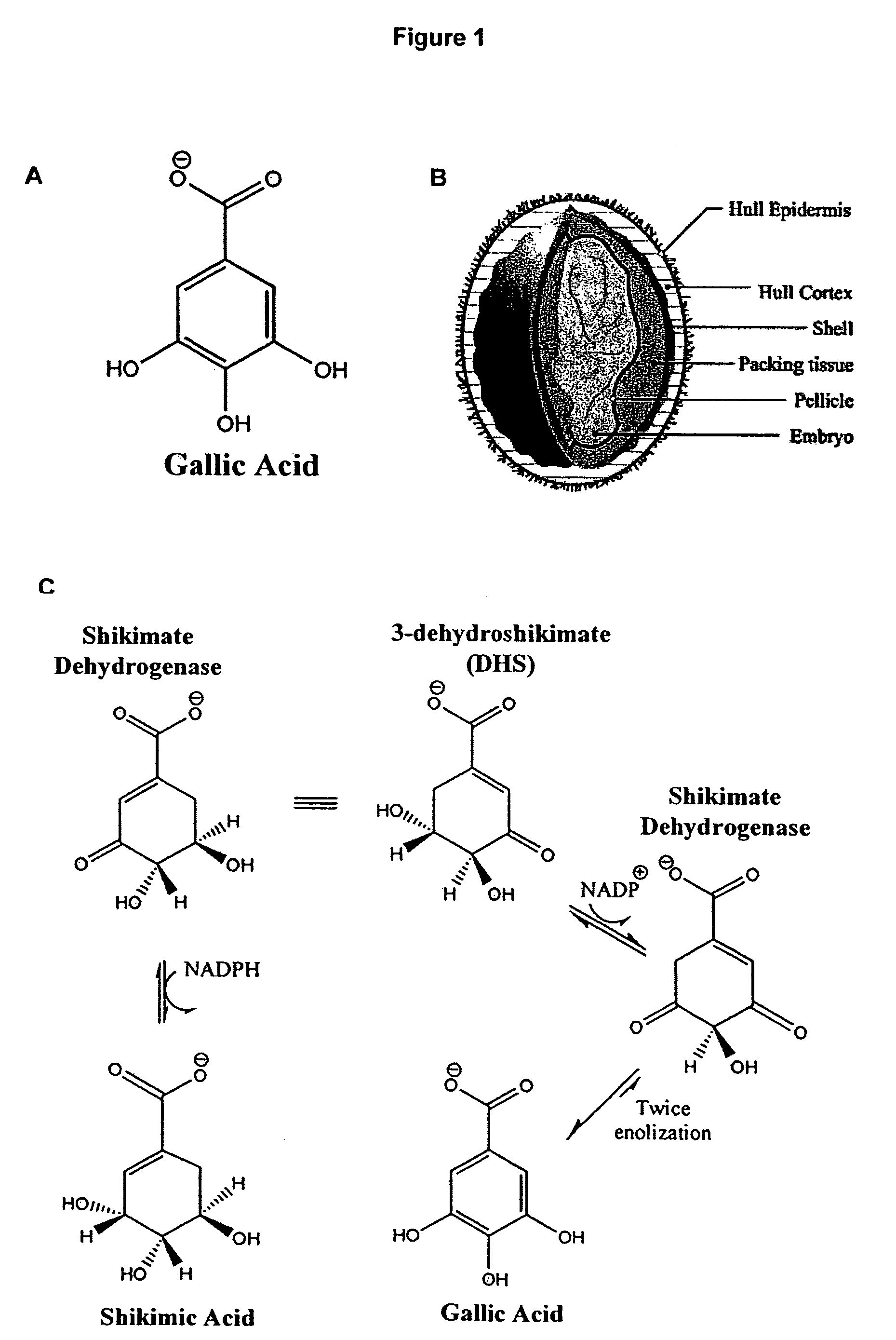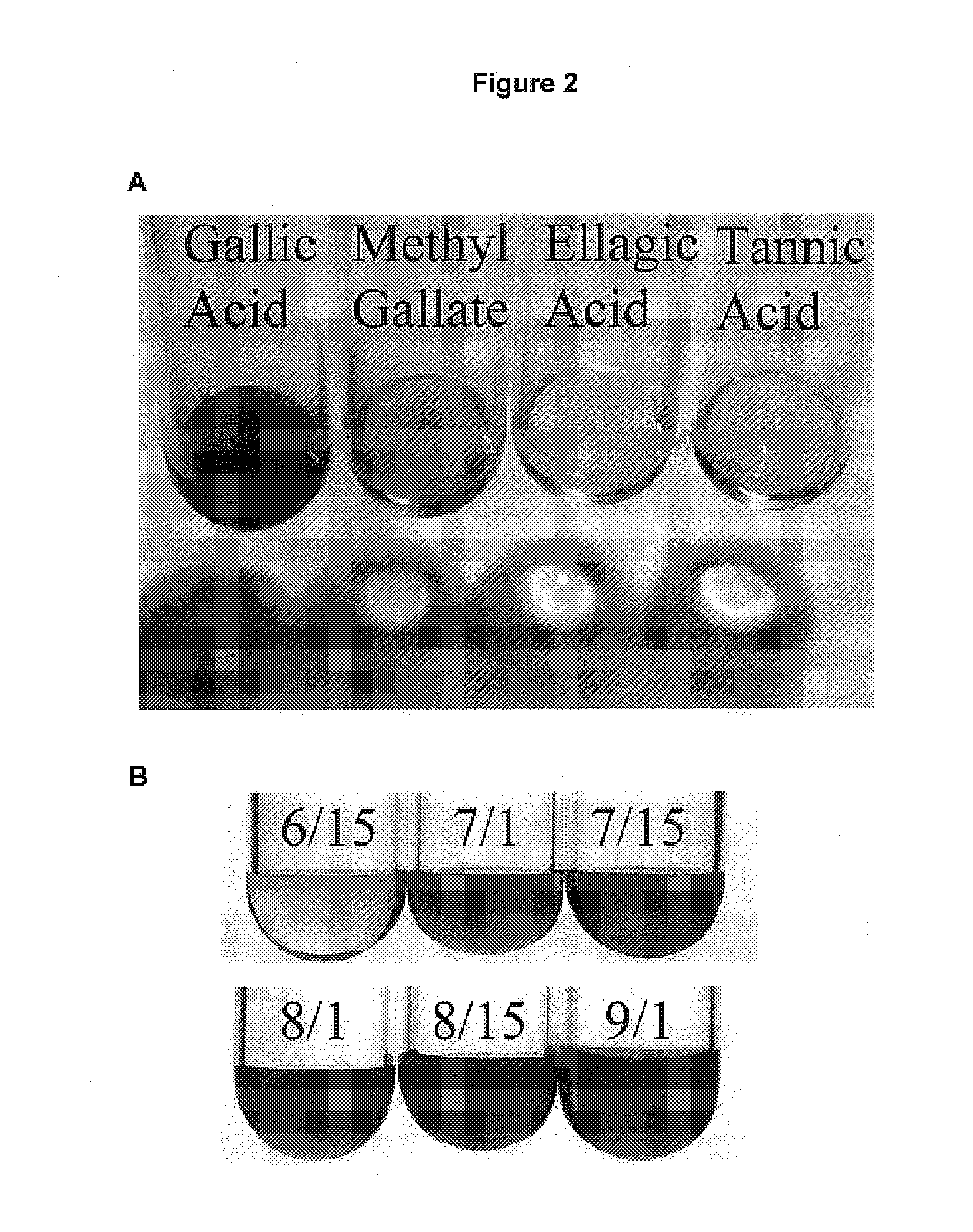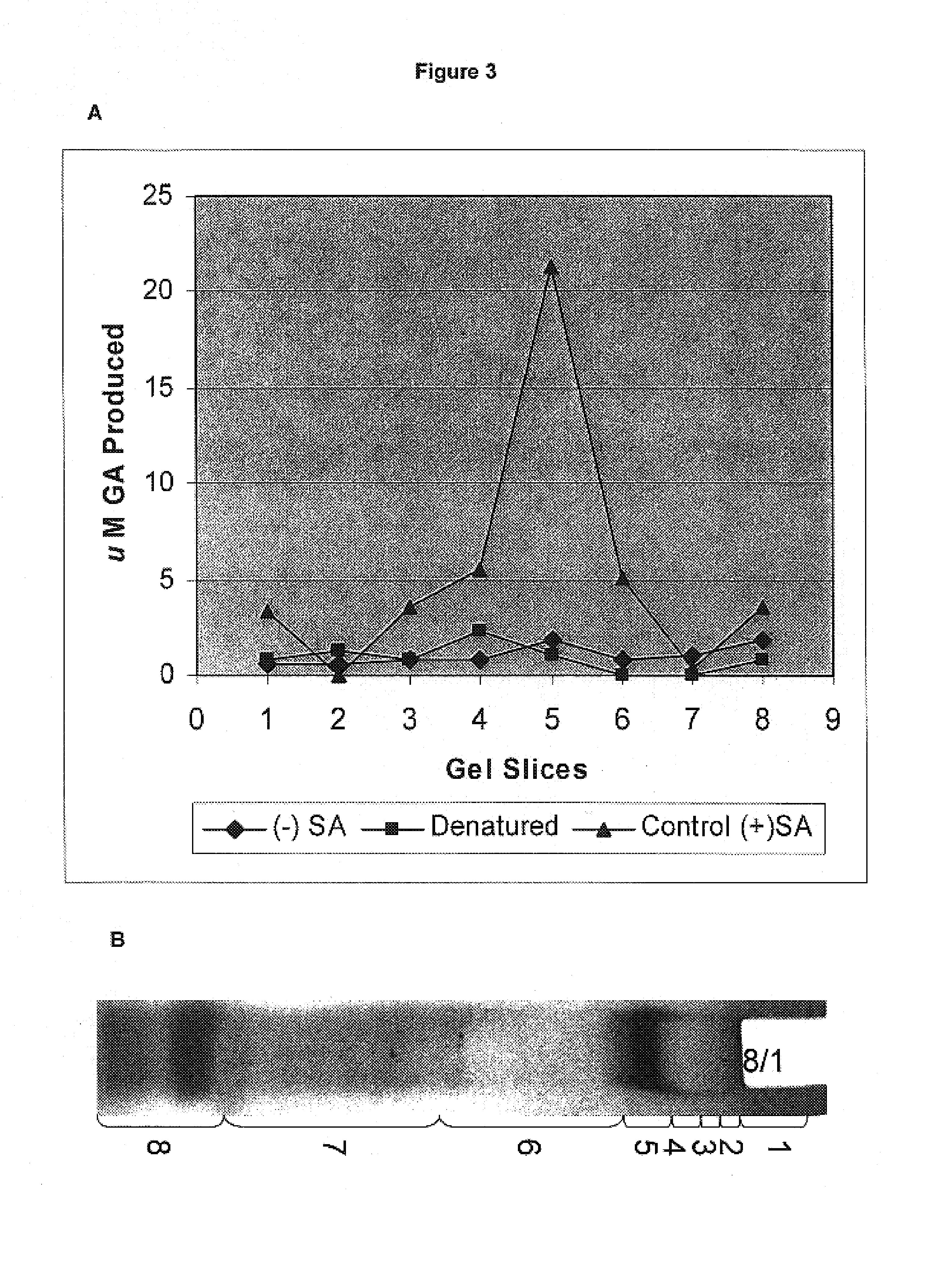Plants with elevated levels of gallic acid/polyphenol oxidase and methods of generating such plants
a technology of polyphenol oxidase and plants, which is applied in the field of plants with elevated levels of gallic acid/polyphenol oxidase and methods of generating such plants, can solve the problems of high-producing dairy cows that require expensive protein concentrate supplements, high-producing bacteria and other problems, and achieves less carbon flow, increased levels, and less carbon flow
- Summary
- Abstract
- Description
- Claims
- Application Information
AI Technical Summary
Benefits of technology
Problems solved by technology
Method used
Image
Examples
example 1
Gallic Acid Detection in Tulare Pellicle
[0248]Chemicals: Gallic acid, gallic acid methyl ester (methyl gallate), ellagic acid, and tannic acid were purchased from Sigma Chemical Co., USA. Rhodanine was purchased from Fluka AG, Germany. All chemicals were of analytical grade.
[0249]Extraction of Gallic Acid: Tulare pellicle tissue was harvested at two week intervals over the growing season (June 15, July 1, July 15, August 1, August 15, and September 1), immediately flash frozen in liquid N2, and stored at −80° C. until use. 100 mg of each tissue sample was incubated in boiling 80% EtOH (1 mL for 10 min). After a quick chill on ice, the tissue was pelleted (13,415 g for 20 min at 4° C.) and the supernatant was subsequently transferred to a fresh tube. The liquid was then evaporated off in a vacuum overnight. Citrate buffer (0.5 mL of 0.05M, pH5.0) was added to each tube and used to resuspend the gallic acid.
[0250]Detection of Gallic Acid: Levels of gallic acid were measured using the ...
example 2
Isolation of the Gallic Acid Anabolic Activity from Tulare
[0251]Extraction of Total Soluble Proteins: Tulare pellicle tissue was harvested on August 1, flash frozen in liquid N2, and stored at −80° C. until use. One gram of sample was homogenized in 2 mL of cold extraction buffer (0.05 M Tris, 0.007M citric acid monohydrate, 0.006 M cysteine HCl monohydrate, 0.01 M ascorbic acid, 0.001M polyethylene glycol 8000; pH 8.3). The slurry was centrifuged at 13,000 g for 25 min at 4° C. The supernatant containing the proteins was transferred to a fresh tube.
[0252]Fractionation and Detection: The protein sample was loaded onto two consecutive lanes of a native polyacrylamide TBE gel. The gel was run for 2 hrs at 110V in the cold. Following fractionation, the two lanes were separated and stained as follows: 1) proteins from one lane were incubated in the presence of shikimic acid, NADP, MTT, and PMS, as described by Tanksley et al., 2) the second lane was divided into eight sections and stain...
example 3
Cloning the Shikimate Dehydrogenase Gene from Tulare
[0253]Degenerate Primers: The nucleic acid sequences of shikimate dehydrogenase from Arabidopsis, tomato, tobacco, rice, and pea were aligned using the program DNAstar. Conserved regions were identified and used to design two sense and two antisense degenerate primers. The sequences of the 5′ primers were: 1)
[0254](5′ShDe-1) 5′-CAC(C / T)TACAG(A / G)CC(A / C)A(A / C)(A / T)TGGGAAG(A / G)GG(C / T)CA(A / G)TATG(A / C) (A / T)GGTGATGA-3′ (SEQ ID NO: 61) and
[0255]2) (5′ShDe-2) 5′-GT(C / T)ATGGG(A / C / T)GA(A / G)A(A / G)(A / G)GGTTT(A / G)ATGTC-3′ (SEQ ID NO: 62).
[0256]
The sequences of the 3′ primers were:1) (3′ShDe-1) 5′-(SEQ ID NO:63)TAAGCAA(T / G)(A / T)GCCTTGCC(A / T)GC(T / G)CCACCAGCACC-3′and2) (3′ShDe-2) 5′-(SEQ ID NO:64)GC(A / C)CCCTT(C / T)TC(C / T)TTTGC(A / C)CC(A / G)TAAGCAA(T / G)(A / T)GCCTTGCC-3′.
[0257]Amplification and Cloning: RNA isolated from Tulare pellicle, harvested May 29, was converted into single stranded cDNA using the ProSTAR First-Strand RT-PCR Kit (Invitrogen). T...
PUM
| Property | Measurement | Unit |
|---|---|---|
| molecular weights | aaaaa | aaaaa |
| molecular weights | aaaaa | aaaaa |
| molecular weights | aaaaa | aaaaa |
Abstract
Description
Claims
Application Information
 Login to View More
Login to View More - R&D
- Intellectual Property
- Life Sciences
- Materials
- Tech Scout
- Unparalleled Data Quality
- Higher Quality Content
- 60% Fewer Hallucinations
Browse by: Latest US Patents, China's latest patents, Technical Efficacy Thesaurus, Application Domain, Technology Topic, Popular Technical Reports.
© 2025 PatSnap. All rights reserved.Legal|Privacy policy|Modern Slavery Act Transparency Statement|Sitemap|About US| Contact US: help@patsnap.com



